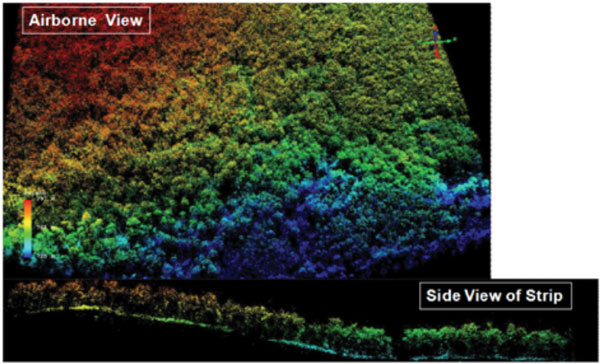Laser Mapping Gets an Upgrade
Fall
2015
Feature
Laser Mapping Gets an Upgrade
Sigma Pi Sigma alum develops 3D lidar tech to be launched into space
By:John J. Degnan Sigma Pi Sigma, Drexel University, Class of 1967 Chief Scientist, Sigma Space Corporation in Lanham, MD

An airborne lidar (light detection and ranging) generates a 3D image of underlying terrain using a laser. It requires precisely measuring time of flight to the surface and knowing the origin and direction of the beam in the terrestrial reference frame, which are determined by monitoring the position and attitude of the aircraft (via an airborne GPS receiver and inertial measurement unit) and the instantaneous pointing of an optical scanner that rapidly redirects the beam(s) during flight for maximum surface coverage. The result is an ensemble of measurements, referred to as a point cloud, that contains the surface topography plus some number of noise counts.
Civilian applications include large-scale surveying and construction projects, forest and biomass management, flood plain analyses, river or channel depth measurements, cloudtop height determination, and cryospheric studies in the polar regions. Military applications include large-scale surveillance and reconnaissance, the identification of enemy hardware under trees, and the detection of undersea mines and submersibles.
Single-photon lidars (SPLs) are the most compact and efficient version of the technology for airborne or spaceborne topographic mapping. Compared to conventional multiphoton lidars, they require orders-of-magnitude lower laser pulse energies and relatively small telescope apertures. On the negative side, however, SPLs are much more susceptible to solar noise during daytime operations and require more aggressive filtering techniques.
Over the past decade, Sigma Space Corporation has successfully demonstrated an increasingly capable series of airborne SPLs based on frequency-doubled, subnanosecond-pulse Nd:YAG lasers operating at the green 532 nm wavelength. The green wavelength, besides permitting the use of high-efficiency commercial off-the-shelf detectors, is highly transmissive in water, enabling the generation of combined topographic and bathymetric maps via a single instrument.
Sigma has designed three scanning SPLs meant to operate at different altitudes above ground level: our Leafcutter (3,000 to 8,000 feet), our High Resolution Quantum Lidar System (HRQLS, 7,000 to 12,000 feet), and our High Altitude Lidar (21,000 to 34,000 feet).
All of these technologies increase surface measurement rates by 2 orders of magnitude, reaching speeds of 3.2 megapixels per second, thanks to an array of 100 beamlets generated by a passive diffractive optical element placed in front of a 32 kHz laser. Higher measurement rates translate to either faster surface coverage and lower operational costs or improved horizontal resolution—or some combination of these benefits.
Unlike competing SPLs, the speed of our combined detector and timing receiver into which the beamlets are imaged allows the lidars to view multiple photon events per pixel per pulse within a wide range gate. That makes our lidars capable of daylight operation and able to penetrate semiporous volumetric scatterers such as tree canopies, turbid water columns, thin clouds, and ground fog.
Each laser pulse from one of our SPLs generates a 10x10 pixel 3D image of the illuminated area. These individual images are mosaiced together into a contiguous image by proper matching of the aircraft motion with the rotational speed of a conical optical scanner. Our High Altitude Lidar system, operating at 30,000 feet with a 9 degree half cone angle (swath = 2.9 km) at a maximum ground speed of 246 knots (456 km/h), can provide contiguous topographic maps at rates up to 2.9 x 456 km/h = 1320 km2/h.
In addition to hardware and performance improvements, much of our current research effort is devoted to rapid and highly automated data filtering and processing with an eye toward generation of quality contiguous 3D images that can be viewed in near real time by the pilot or transmitted to a ground station by an unmanned aerial vehicle (UAV). Our approach uses the spatial/temporal coherence of the nominal 100 surface returns per pulse to filter out solar or other noise within one or a small number of closely spaced pulses. It offers the additional benefits of greatly reduced data storage, transmission, and/or postflight download requirements.
In summary, the several-megapixel-per-second measurement rates and multistop capabilities of our 3D-imaging SPLs offer significant technical and cost advantages over conventional multiphoton or single-photon systems for a variety of civilian, military, and space applications. In fact, the ATLAS lidar on NASA’s ICESat-2 Mission, scheduled for launch in 2017, will use SPL technology.

